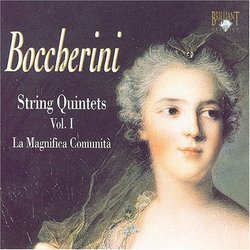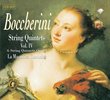| All Artists: Luigi Boccherini, La Magnifica Comunita Title: Boccherini: String Quintets Vol 1 Members Wishing: 0 Total Copies: 0 Label: Brilliant Classics Release Date: 5/31/2005 Genre: Classical Styles: Chamber Music, Historical Periods, Classical (c.1770-1830) Number of Discs: 2 SwapaCD Credits: 2 UPC: 675754837426 |
Search - Luigi Boccherini, La Magnifica Comunita :: Boccherini: String Quintets Vol 1
 | Luigi Boccherini, La Magnifica Comunita Boccherini: String Quintets Vol 1 Genre: Classical
|
Larger Image |
CD DetailsSimilar CDs |
CD ReviewsSmall ensembles of excellence Daniel E. Oaks | Rhode Island U.S.A. | 04/12/2006 (3 out of 5 stars) "I have read that "La Magnifica Communit? was founded 15 years ago as an ensemble-and I quote, now, from their publicity blurb-"deeply convinced of the importance of philological and stylistic research in order to understand the music of bygone ages." That's as it may be, but in these performances devoted to the op. 10 string quintet collection of Boccherini they offer technical expertise, sharp accenting, singing tone, cantabile phrasing, a broad range of dynamics, rich but varied textures, a feeling for collective music-making, and attentiveness to tempo markings and the score: in short, all the qualities that have traditionally marked small ensembles of excellence for nearly a century, without much ado over their philological antecedents. This is not meant sarcastically; I couldn't muster a jibe, even if I'd been seeking one, after the good humor induced by performances such as these. But I find it ironic that the banner of authentic performance has led LMC back to exactly the same place as other fine Boccherini stylists of 30 years ago and more. These musicians differ from their earlier colleagues in only one respect: a lack of vibrato. The results are attractive, however, without the rasp, whine, or wow that passes among poor performers for good tone. The music itself was published in 1771 but is in the composer's mature style, with all the variety of mood, structure, and source materials that this implies. I disagree strongly with the liner notes that refer to the "conventional four movement plan" in these works. Even if we allow that an international consensus on string quintet form had already evolved, which it hadn't, Boccherini ignores it in favor of six different solutions to what makes an effective string quintet. For example, the second of the set starts with a lengthy, moderately slow movement, marked simply "amoroso," while its second movement of equal size is a zestful, fully elaborated symphonic finale-with two shorter movements to follow. The third quintet begins with an allegretto that's more than twice the length of any of its other three movements, and the last two quintets in the series explore variations on three-movement forms. The content is as varied, touching upon Spanish and Italian models, classical and indigenous materials, various Baroque and evolving Classical traditions. Engineering is good, balancing the five participants in a small hall environment, with a layer of resonance that never blurs the textures. Highly recommended, even more so since this is labeled Volume 1. Let's have Volume 2 soon, if you please." I await" Boccherini's First Quintets - and Wow! N. Cook | 04/26/2008 (5 out of 5 stars) "Luigi Boccherini is known as a master of chamber music, especially for his string quintets as he produced around 125 of them, most of them being scored for string quartet + an extra cello. This collection showcases the first six quintets that Boccherini wrote and he certainly seems to have started off well. The first quintet starts off with a warm, "light-hearted seriousness" but contains a very lonely Largo that alternates between wistfulness and regret. The third quintet has a very "curiously playful" minuetto that contains bursts of forte that make it almost impossible not to wave your arms. This is followed by a stormy and dramatic Presto that is intriguingly endearing if anything. The fourth quintet starts off barely audibly in its introduction and builds to a very warm and welcoming Allegro. This quintet is based on his Opus 7 C Major symphony and his "Symphony with concertante guitar" written at the end of his life (and a companion piece to his guitar quintets) is in turn based on this quintet. Finally, the last quintet opens with a Pastorale and Allegro that Boccherini would later use to introduce his "Fandango" for string quintet which was later transcribed into its most well-known embodiment for string quartet + guitar (the tempo on the Pastorale is a bit fast here I think, so try the guitar quintet version by Europa Galante for best results). In all, these quintets show a glimpse of what his style would look like as he went on to write many more. Each has its own intrigue and peculiarities about it and perhaps "peculiarity" and "intrigue" are great words to describe Boccherini's work as a whole. If this is your first exposure to Boccherini it is wise to beware that he had his own musical language that is pretty distinct from Haydn and Mozart. It seems that he was primarily interested in weaving a sort of "musical tapestry" with his melodies, sort of the music world's counterpart to the tapestry and wallpaper designs of William Morris. "Music for music's sake." All this to say that he had his own ideas about his craft that may not readily fit in to one's expectations of chamber music. If you really listen though and let him be himself, you should find him to be a uniquely talented composer. La Magnifica Communita does a great job though the recording sounds a bit "far off" which tends to slightly blur the distinction between each instrument. However, this doesn't detract in any major way. I know this is the opposite of what the previous reviewer said, so listen for yourself and see what you think. Everything considered, this is a great album!" The Keats of Music? Giordano Bruno | Wherever I am, I am. | 02/09/2010 (5 out of 5 stars) "In his Ode to a Grecian Urn, the English poet John Keats penned the most eloquent defense of an aesthetic of beauty ever:
Thou still unravish'd bride of quietness, Thou foster-child of silence and slow time, Sylvan historian, who canst thus express A flowery tale more sweetly than our rhyme: What leaf-fring'd legend haunt about thy shape Of deities or mortals, or of both, In Tempe or the dales of Arcady? What men or gods are these? What maidens loth? What mad pursuit? What struggle to escape? What pipes and timbrels? What wild ecstasy? Heard melodies are sweet, but those unheard Are sweeter: therefore, ye soft pipes, play on; Not to the sensual ear, but, more endear'd, Pipe to the spirit ditties of no tone: Fair youth, beneath the trees, thou canst not leave Thy song, nor ever can those trees be bare; Bold lover, never, never canst thou kiss, Though winning near the goal - yet, do not grieve; She cannot fade, though thou hast not thy bliss, For ever wilt thou love, and she be fair! **** O Attic shape! Fair attitude! with brede Of marble men and maidens overwrought, With forest branches and the trodden weed; Thou, silent form, dost tease us out of thought As doth eternity: Cold Pastoral! When old age shall this generation waste, Thou shalt remain, in midst of other woe Than ours, a friend to man, to whom thou say'st, "Beauty is truth, truth beauty," - that is all Ye know on earth, and all ye need to know. So what does Keats (1795-1821) have to do with Luigi Boccherini (1745-1805)? Well, their lives overlapped, and they both died of tuberculosis, but my insight (if I may call it one) is that the poet and the composer shared an aesthetic of perfectly wrought beauty. Keats's life may have been a subject for Romance - early death always is - but his poetry is misunderstood if labeled 'Romantic'. The Ode to a Grecian Urn, and most of Keats's greatest poems, is thoroughly Rococo, as ornate and artifice-laden as these six Quintets op. 10 by Boccherini. It's the unmatched artifice of both that amounts to Beauty, and therefore to Truth. Boccherini published his first six Quintets with two cellos in 1771, shortly after he'd committed himself to a career in Spain that extended for the rest of his life. The quintets were written and published, like all such chamber music of the period, for the enjoyment of musicians - players, not listeners, both performing professionals and amateurs. My apologies to all music lovers who listen but never play, but the greatest pleasures of chamber music are not for you. There's a level of sheer physical pleasure in such music that only the player can experience, and that was the level to which Boccherini was most devotedly attentive. So.. if you really want to love this music, get out your "air cello" and saw along! This is music to 'hear' with your proprioceptive body. [That notion, by the way, is developed brilliantly in the scholarly book "Boccherini's Body" by cellist/musicologist Elizabeth Leguin.] Boccherini has been persistently labeled a composer of the second rank, charming but not profound. In fact, he was an innovator of the first rank, in some ways a century and a half ahead of his contemporaries. This first set of Quintets established the structural possibilities of a form that was in effect Boccherini's own invention. Pay attention, for instance, to what the composer 'discovers' about the acoustic variety - the interior duos, trios, quartets - possible in a quintet. But Boccherini was also exploring the virtuosic capabilities of the string instruments themselves: the resonances and timbres, the sounds that could be extracted by different uses of the bow, the upper range of the cello, his own instrument. Boccherini was by far the first composer to treat the cello as the dominant voice in the quintet or quartet, and he was 'way ahead' of his Austrian "husband" in distributing the musical interest of his quintets to all five instruments in balance. Pay attention to the sound effects Boccherini achieves by deliberate doubling at octaves and by tricky double-stopping. Sound effects! This is music 'profoundly' attentive to sound as such, rather than to melodic architecture. Not until the 20th C was any composer so profoundly attentive to sheer Sound. The excitement really gets going with Quintet IV, and builds through V and VI. But there's more than just acoustic stimuli to this music. There's also Boccherini's discovery of Spain, of an Iberian musical heritage that Northern Europe was forgetting. Boccherini, the Italian wanderer, was to become the Founding Father of modern Spanish classicism, preserving and formalizing the 'fandango' spirit of the Spanish Golden Age. There's plenty of profundity in Boccherini's rediscovery of the New World. La Magnifica Comunità deserves its name; they play magnificently on their 'period' instruments, and their 'period' instruments serve the musical vocabulary of Beccherini's quintets in ways that 'modern' strings can never match. The ensemble is attempting to record all 176 (one hundred seventy-six!) of Boccherini's quintets, over a period of years. So far they have released seven volumes, up to opus 27 of 1779, so they are still short of half way. All seven recordings are "Magnifica"!" |

 Track Listings (12) - Disc #1
Track Listings (12) - Disc #1

